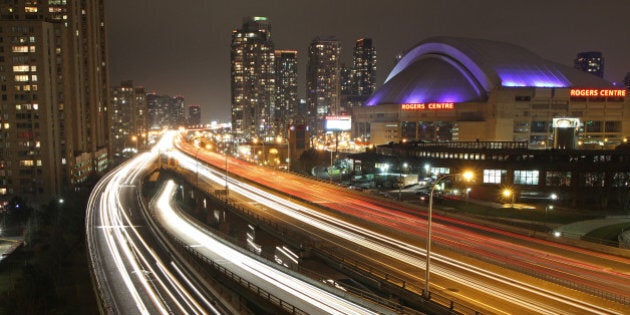
Chopping off Gardiner East may be bad for your environment and stress levels, and will likely worsen pedestrian safety and drivers' stress levels.
Toronto's medical officer last week argued that replacing Gardiner East with an eight-lane boulevard (the Remove Option) is preferred over realigning Gardiner East (the Hybrid Option) to connect with the DVP.
This is one case where I argue the doctor does not know best. Using the same data as the Toronto Board of Health I conclude differently. Why? I believe the good doctor and his team have made a selective read of the data, which has influenced their conclusions. The fate of Gardiner East must be decided on all facts and figures and not the ones we cherry-pick.
Let me state my assertions. I believe that the Remove Option is likely to generate more, not fewer, Greenhouse (GHG) Gas emissions. The Remove Option increases the odds of pedestrian-automobile collisions more than the Hybrid Option. Furthermore, transport and public health research documents higher levels of stress for those subjected to frequent traffic congestion.
My key piece of evidence comes from the City itself. The Environmental Assessment (EA) report, commissioned by the City, concludes that the Remove Option will generate an additional 1.9-million vehicle hours travelled annually of congested traffic flow more than the Hybrid Option. The resulting 114-million minutes of congested travel annually is likely to generate more GHG emissions, worsen pedestrian safety, and drivers' stress levels.
Let's look at this in some detail.
Greenhouse Gas Emissions
The EA report mentions that the Remove Option will generate 12 per cent fewer greenhouse gas emissions than the Hybrid Option. This assertion is primarily based on the expected decline in the Vehicle Kilometres Travelled (VKT) for the Remove Option. I contend that this may not be true mainly because the Remove Option is expected to generate 1.9 million vehicle hours of travel more than the Hybrid Option.
Furthermore, the expected decline in VKT does not account for the fact that most trips will be re-routed to other streets, as was the case in Embarcadero Boulevard in San Francisco. The re-routed trips will generate GHG emissions, even if the trips are not captured in the study area.
The greenhouse gas emissions are a by-product of burnt fuel by the vehicles. Even when the vehicles are travelling for fewer kilometres, they will operate for longer hours because of congestion, as will be the case with the Remove Option. Thus, the excess vehicle operations are likely to generate higher greenhouse gas emissions. How much, I estimate the additional 1.9 million vehicle hours travelled will likely generate 19,900 metric tons of CO2 emissions, a net increase over the Hybrid Option.
The City's medical officer states that the Remove Options adds a mere 52 seconds to each vehicle's travel time, which "is not expected to have an impact on health." But the devil is in the detail.
The average increase of approximately 52 seconds per vehicle trip aggregates to approximately 1.9 million additional vehicle hours of travel each year with the Remove Option. Not a small number to disregard.
Pedestrian Safety
The City's medical officer also states that the "Remove option is anticipated to be better for health for the transportation lens," especially considering pedestrian safety. I conclude exactly the opposite. Pedestrian safety worsens with an increase in the exposure of pedestrians to traffic operating at speeds greater than 60 km/hour.
The Boulevard option increases the odds of collisions for the following reasons. First, pedestrians will have to cross eight lanes plus the dedicated turning lanes in the future with the Remove Option. At present, pedestrians essentially have to cross six lanes, depending upon the intersection layout. The increase in the number of lanes at signalized intersections increases the odds of collisions between pedestrians and vehicles.
Second, the Remove Option is expected to absorb the traffic currently carried by the six lanes of Gardiner Expressway and the six lanes of the Lakeshore Boulevard. The resulting Boulevard will, therefore, have a much higher traffic volume than the current flow on the Lakeshore Boulevard. The increase in traffic volume increases the odds of collisions between pedestrians and vehicles at signalized intersections and mid-block. Also, remember the current traffic flow absorbed by the Gardiner Expressway does not impose any threat to pedestrians because of it being carried on an access-controlled freeway.
Third, the Remove Option will likely result in an additional 1.9 million vehicle hours of travel in congested flow conditions, which are likely to contribute to drivers' frustration. Such traffic conditions are expected to worsen pedestrian and bicyclist safety.
Congestion Induced Stress
Public health and transportation planning research documents a positive link between an increase in traffic congestion and stress levels of drivers and transit riders. My own research, using data from Statistics Canada, revealed that the probability for stress increases by 65 per cent for those who experience traffic congestion three or more times a week.
Since the Remove Option will result in an additional 1.9-million vehicle hours of travel in congested flow conditions, those commuters are likely to be exposed to high levels of stress, which will adversely affect their health.
Also, the Remove Option may make driving conditions more hazardous for automobile drivers who would share the same road space with large trucks. The Remove Option proposes narrower lane widths of 3.3 meters for the redesigned boulevard. The rest of the Lakeshore Boulevard will have 3.9-meters wide lanes. The sudden reduction in lane widths in mixed traffic with trucks will add to drivers' anxiety and stress.
Facts, and not fiction, should decide the future of Gardiner East. Cherry picking facts will lead us to conclusions that defy logic and physics.
MORE ON HUFFPOST:
